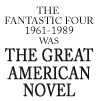







 |
 |
 |
 |
 |
 |
 |
 |
When I was younger I could never finish Kirby's writing. Even now I find it requires more work. But as I grew up I got hooked on classics. I read the Bible, Shakespeare, and Greek myths. I explored science fiction and theology and hard science. And as I did so, my love for Jack Kirby's work increased. Now I think Jack Kirby's writing is a hundred times richer and deeper than Stan Lee's, but it isn't as accessible.
Stan will always be the king of mass market escapism. Have you ever come home after a tiring day at work and wanted to escape without being forced to think? You want Stan Lee, not Jack Kirby. Sometimes we need popcorn movies, and other times we need the classics. Nether is "better", both are culture, but they are different. Yet in Stan and Jack's Fantastic Four we got both at once.
Stan Lee and Jack Kirby worked together on the first 102 issues of the Fantastic Four. Issue 103 was only written by Stan Lee (the new artist, John Romita, only wanted to do the art). Those first few pages are a perfect illustration of Stan Lee's easy to read style.
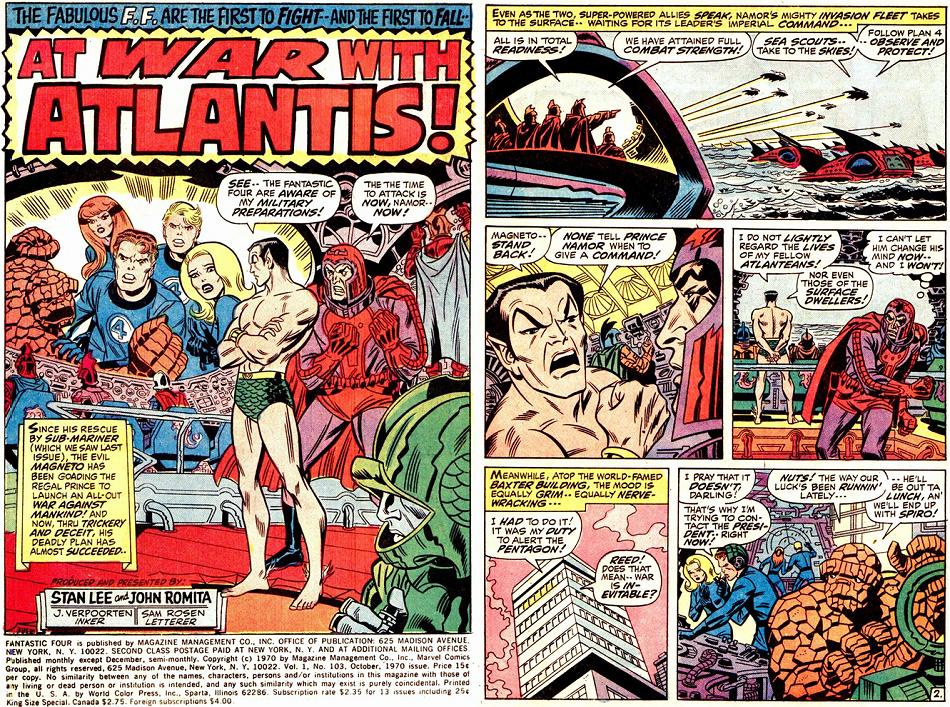
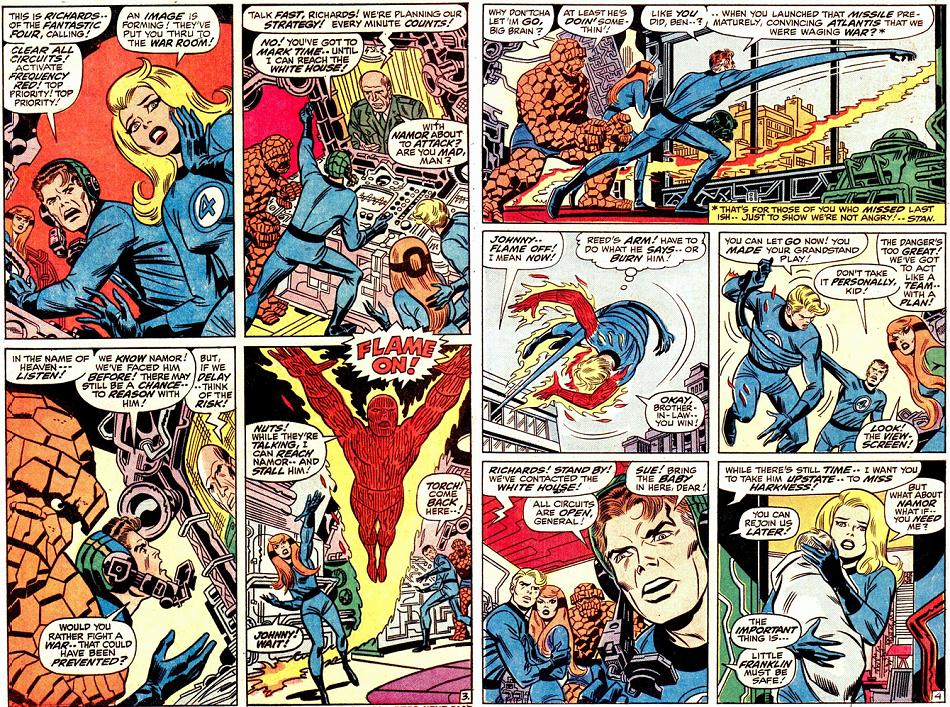
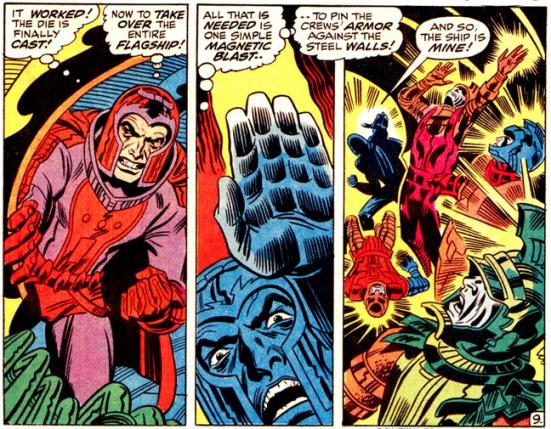
This is easy to understand at a glance. The heroes look very heroic, and the villain is one dimensionally villainous. It is the same story we have seen on a thousand cartoons: the villains attack the heroes and eventually the heroes will win. At every point we know exactly what is happening because the dialog tells us several times. The setting is familiar, and the people are familiar: even if we had never seen this comic before it all feels familiar. This is a comic book! There is nothing demanding about it. it is exactly what we expect from a comic book
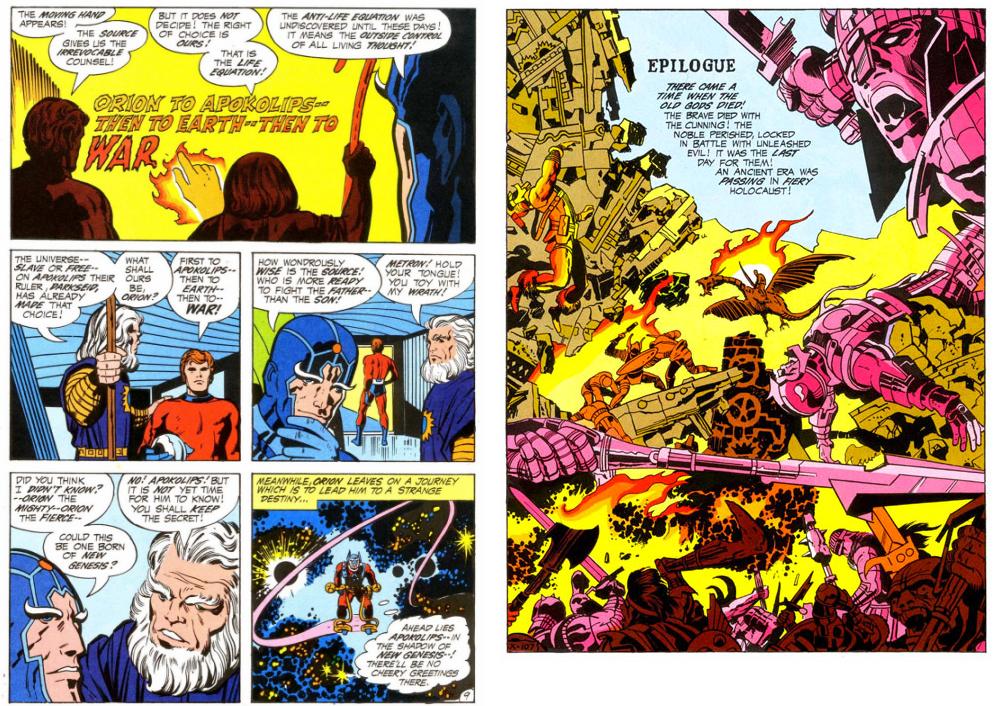
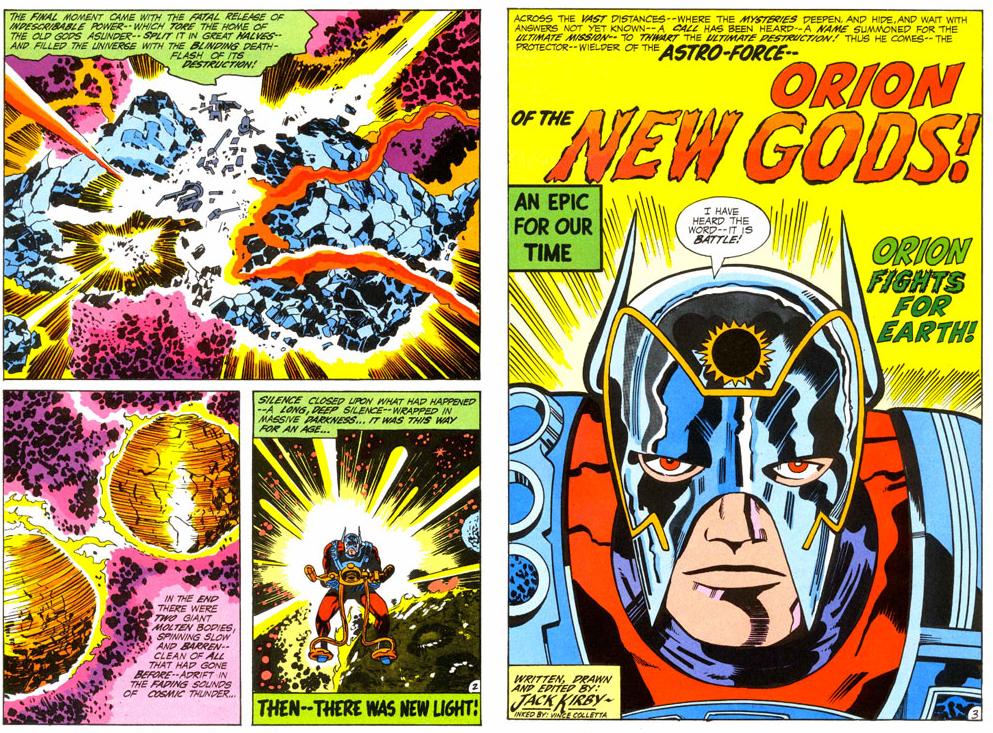
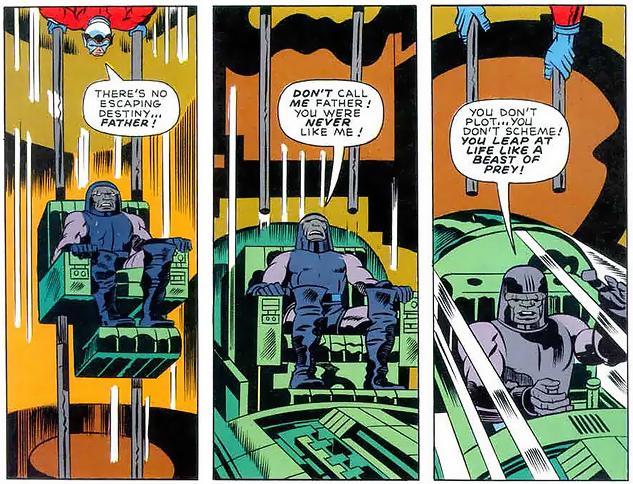
This is much richer stuff. It also deals with war, but this is on a vastly larger scale. The first page is like something from the Bible, specifically the book of Daniel (even down to the allusion to Daniel's writing on the wall). Metron with the others is like Satan discussing with God at the start of the book of Job, when a "satan" was not an evil being but a more complex character drawn from ancient Persian culture.
The second page is like something from ancient mythology. The third page is like the book of Genesis. Metron is nuanced, Darkseid has plans that go far beyond simply launching some armies and being defeated two issues later: this series was designed to never be repeated (though the publishers DC soon forced Kirby to change it into regular heroes versus villains). This is a story of a father versus a son, and of a world where people question the gods and th whole of history ends, to be reborn. It is not a cycle to be repeated, it is a story to stand for all time.
Both Stan and Jack dealt with war, but their stories are like milk and meat.
On a previous page we compared what Stan Lee asked for with what Jack Kirby created (see the synopses to issues one and eight). In my opinion Kirby adds all the best parts: his version is far better.
Does it work both ways? Lee certainly made Kirby's writing more accessible. Without Lee I would never have discovered Kirby, and that is probably true for most fans. But accessibility comes at a cost. Let's look in detail at one cost: how Stan wrote women.
Stan Lee's stories were very accessible. The male hero always won, and the female love interest was there to be rescued and make him look good. As a young man reading comics I could go along with that! But as I grew older and met real women I began to see things differently. Let's look at Kirby and Lee on women: it's a good way to see the difference between their writing.
Jack Kirby always treated women as equal to men. This probably has a
lot to do with his wife Roz: he adored her, and she was an extremely
capable woman: they were a team of equals. Kirby (and his partner Joe
Simon) invented a whole genre: the romance comic. While others were
happy to write comics aimed at boys, Kirby was thinking of the girls as
well. In Kirby's romance comics it's the women who have the depth and
the men are just bit parts.
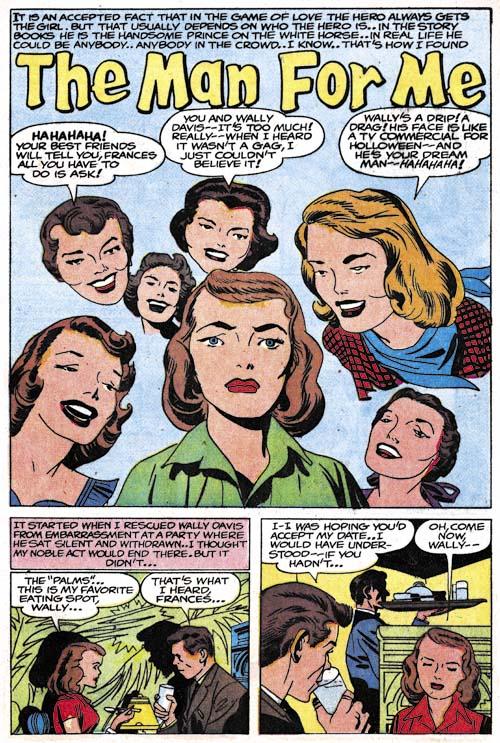
Kirby's equality was clear in his most famous work just before the Fantastic Four: Challengers of the Unknown. Although he was not the official writer, and DC normally gave their artists complete scripts, the writing on this page is pure Kirby. "What's out there?" is such a classic Kirby line! Presumably he was given a script and then made his own changes to improve it.
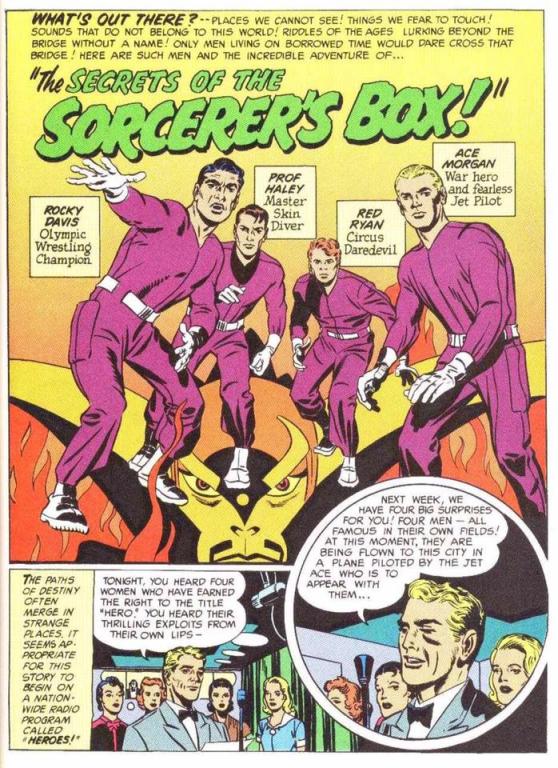
Note that in this, the very first page of the Challengers series, a series that was supposed to be about four men, Kirby put the women first. The Challengers only appeared on the show after four women heroes appeared first. Touches like that are pure Kirby: while he considered that men should protect women, due to men usually being physically stronger, Kirby was dead serious that men and women are equal in courage, heroism, and intelligence.
Kirby carried this on in his Fantastic Four. Here are two covers where Sue Storm must fight alone and saves the men who are all fainting and defeated. One from near the start (FF 5)
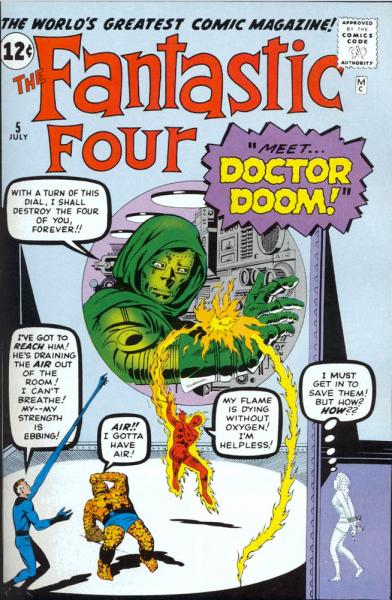
And one from near the end (after Kirby had decided to leave Marvel, and was planning his escape).
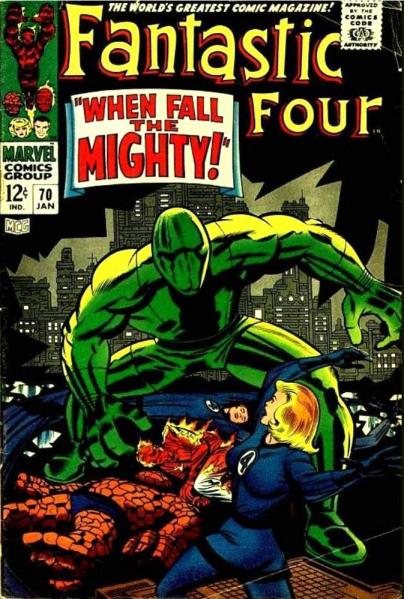
A year later Sue saves the helpless men once again (by going against Reed's instructions to stay home).
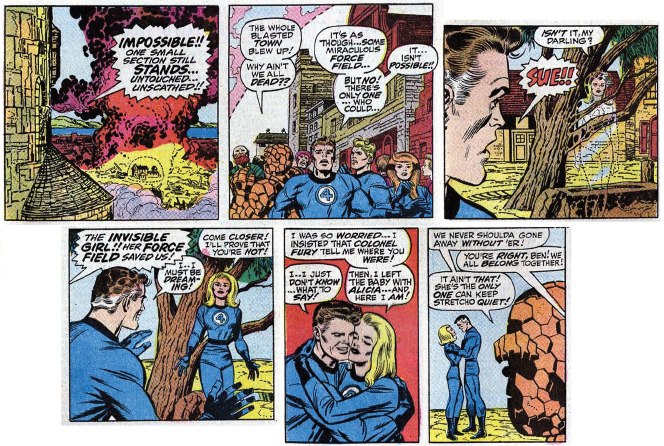
When we look at the art, without Stan Lee's dialog, it is clear that Sue is just as active as anybody else. But then Stan Lee adds dialog to made it sound like Sue is always dependent on the men.
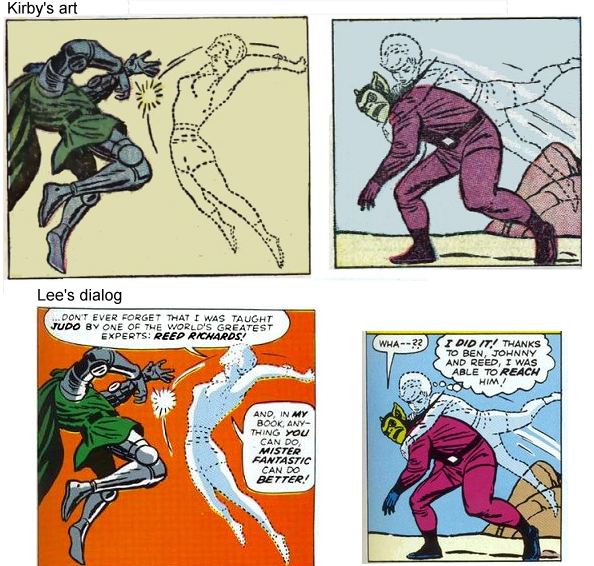
This happens again and again. The previous examples were from FF5 and FF 18. This example is from FF 95:
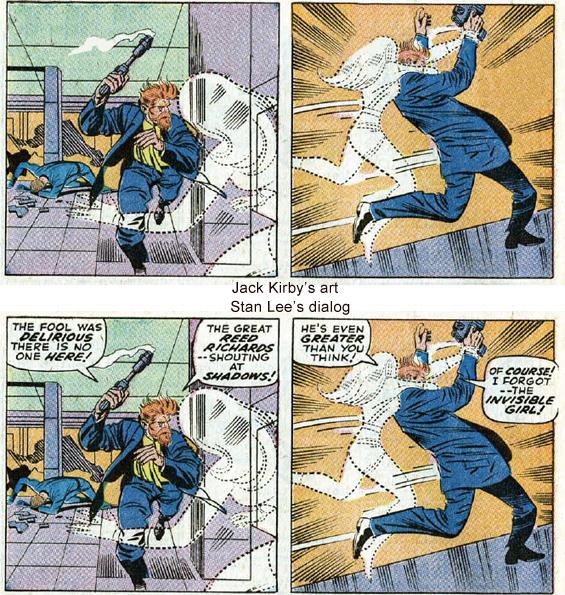
Incidentally, this is less true between the issues in the 30s and issue 67. As far as can be told, by the 30s Stan was so busy that his story conferences were very brief, and Kirby had more control. But issue 67 was when Kirby decided to leave, so after that he put in slightly less effort. After 67 we get a little more Stan. The issues from the 30s to 67 are considered the golden era.
Stan's dialog would always make Sue look weaker, because in the simple world of Stan's comics the woman always had to be rescued by the man. Perhaps this is why Kirby introduced Crystal. We can be fairly sure that Crystal was all Kirby's idea because as soon as Kirby left Stan Lee got rid of her. Crystal was not dependent on Reed, so Stan could not give her as much pro-Reed dialog. So Crystal is constantly saving the team on her own initiative. Crystal comes to stay permanently in issue 99, so let's look at those issues.
In issue 99, as usual, the women are just as powerful as the men.
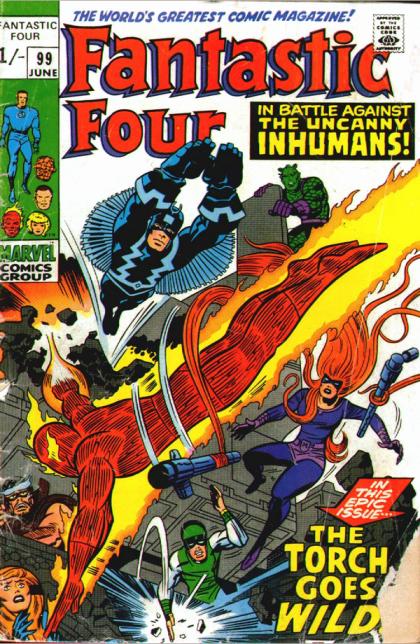
Inside, Crystal is dominant, and later Sue saves the team.
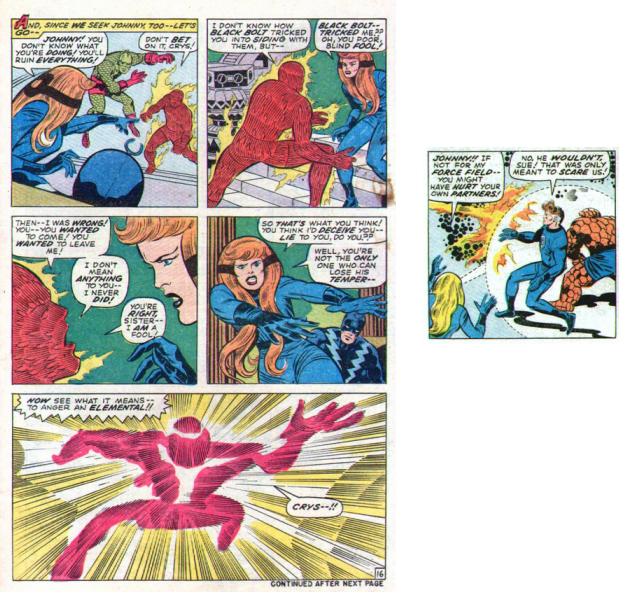
This is the cover to the next issue. Again the women are just as powerful as the men.
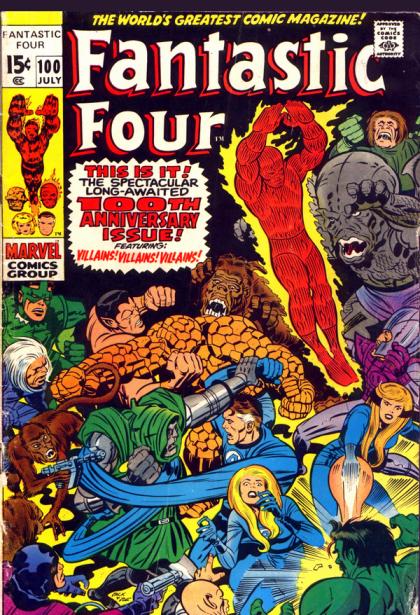
Inside, once again Crystal saves the team. On the first two pages!
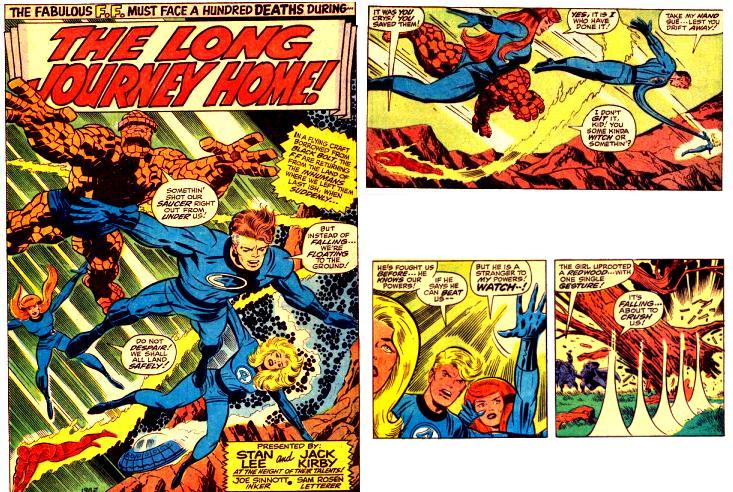
This is next issue: again, men and women have equal status on the cover.
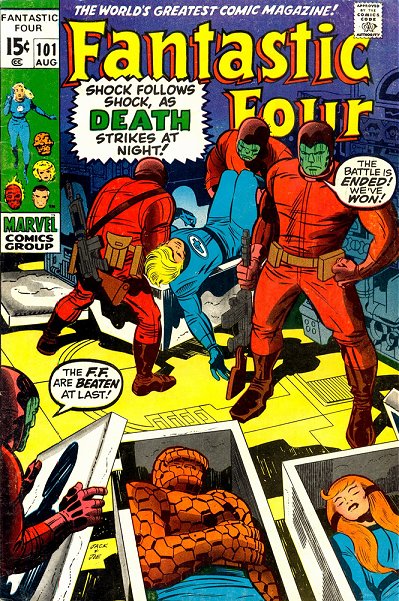
And again, Crystal saves the team.
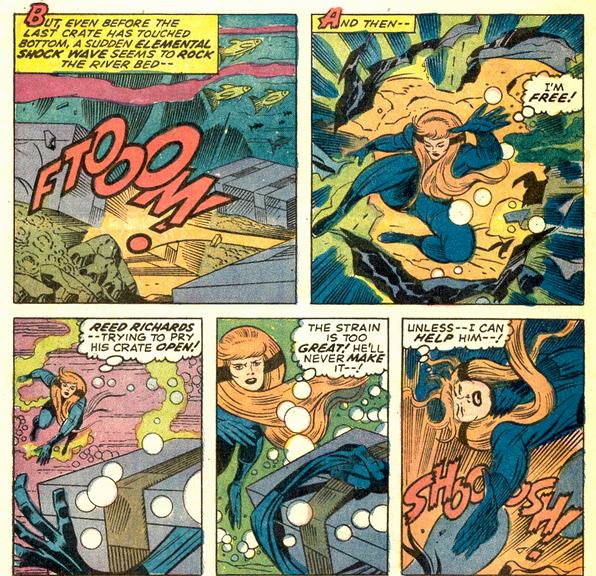
This is the second to last Kirby book, and Sue is magnificent as
usual. Take away the dialog and the story is even better: she is always
strong, always in control.
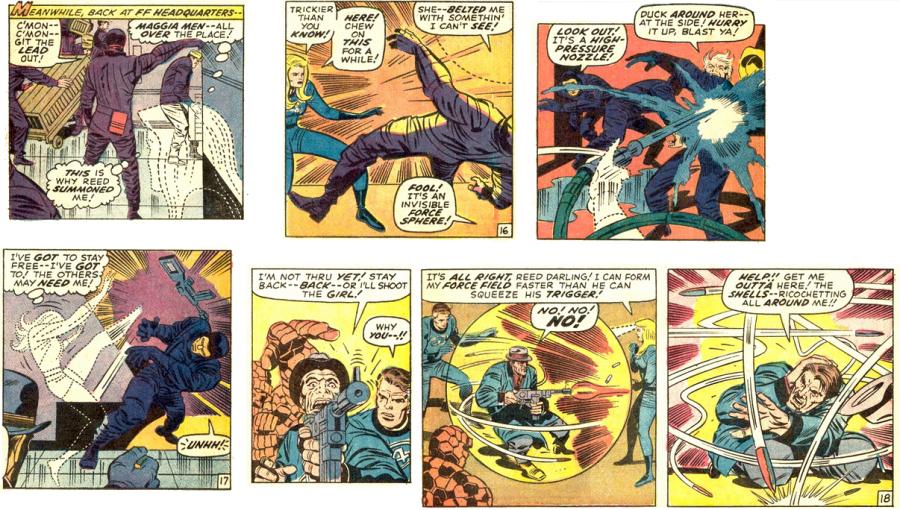
This is the next issue. Kirby's last proper issue, and the first cover that's not by Jack Kirby. Sue is passive on the cover, but not noticeably weak.
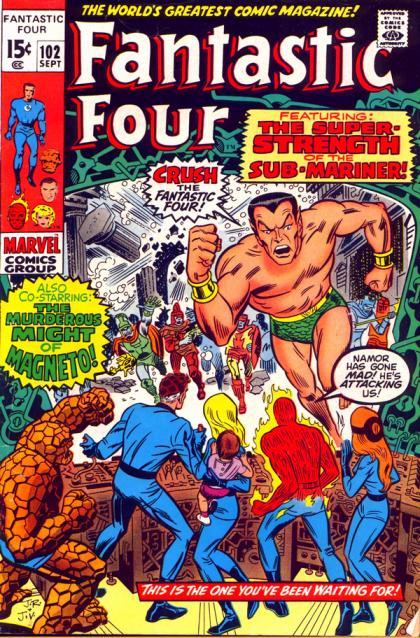
The inside is by Kirby, and once again Crystal is front and center and saves the team.
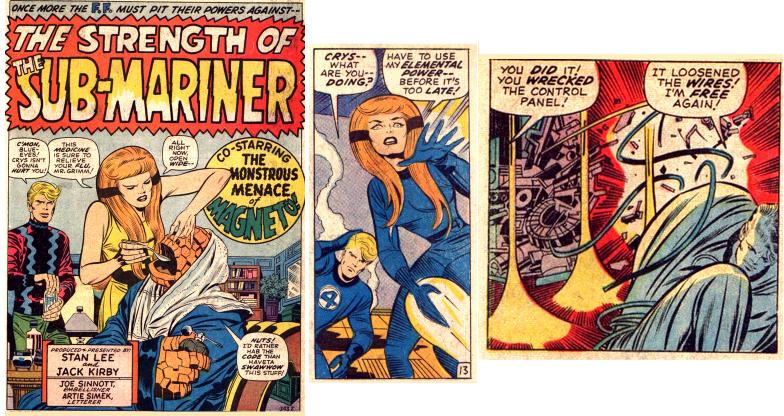
This was Jack Kirby's last issue. He then left Marvel
Comics.
Kirby went on to create more comics where women were just as important as men. In this example a strong woman (Big Barda) reveals the pathetic weakness in a sexist man (Funky Flashman). Kirby modeled the man on Stan Lee, giving us an idea of what Kirby thought of him.
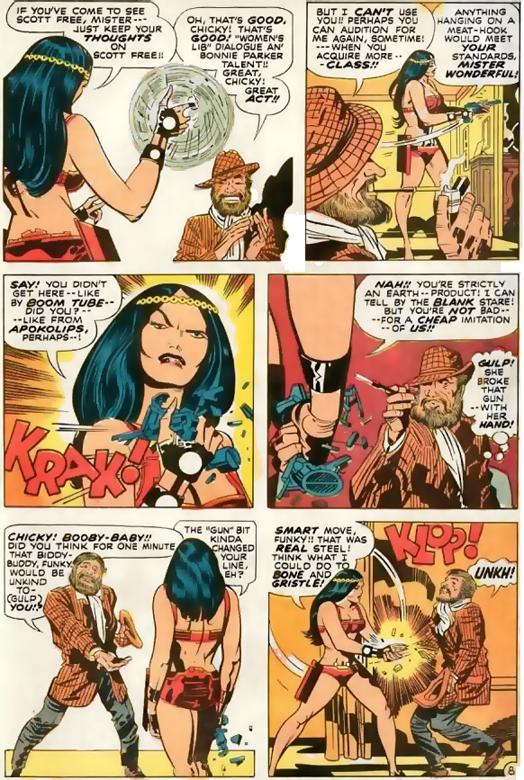
Stan Lee took over all writing from issue 103. The difference is dramatic.
No women appear on the cover to Stan Lee's first story: it's just men doing manly things.
In this first Stan issue, Sue is too weak to save herself and she faints. This is the shape of things to come.
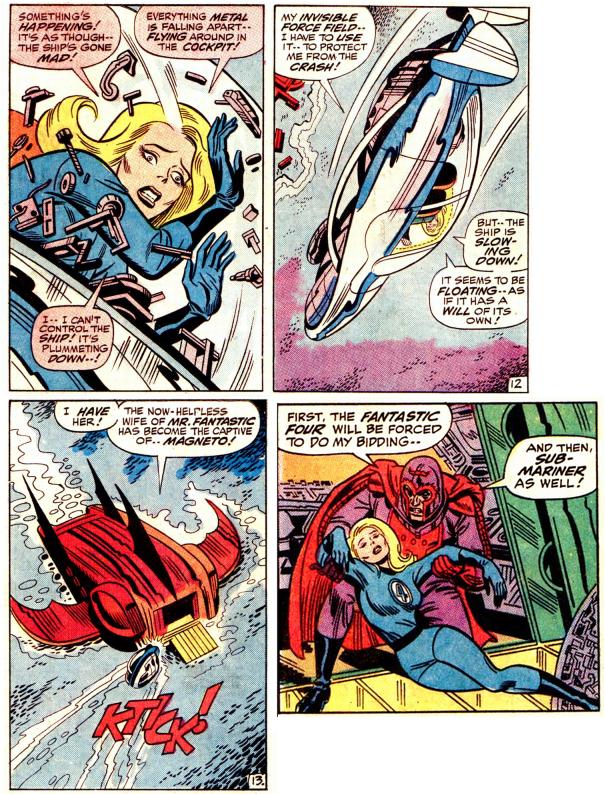
She and Dorma are both helpless hostages. Stan didn't waste a single page.
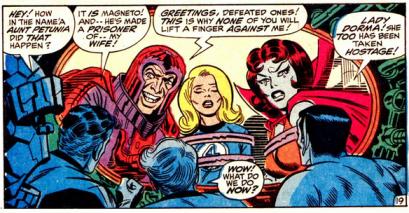
The next cover shows the
women helpless and scared in glass tubes controlled by a man.
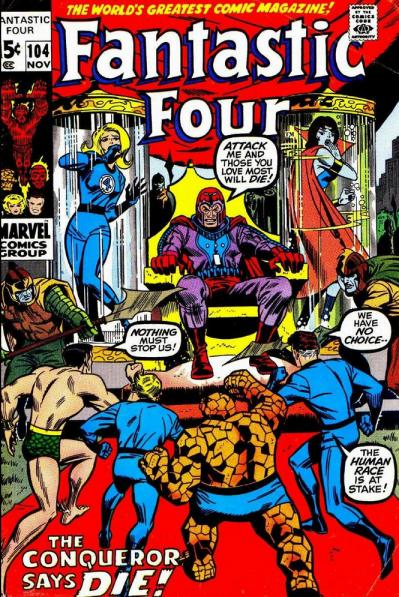
Sue has an almost identical frightened pose on the cover of the next issue
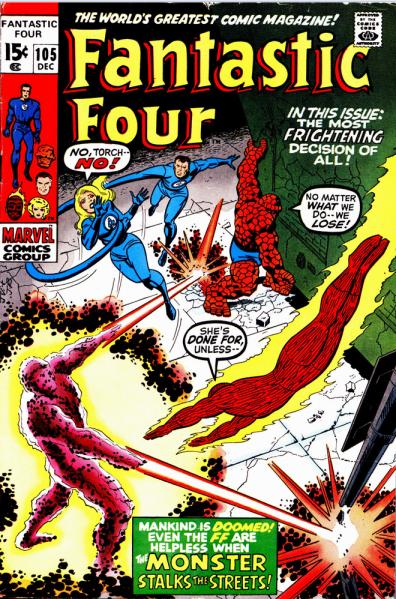
Inside Sue is totally useless without Reed. Johnny says "If Reed knew
the chance you were taking"! Sue says "I only pray that I can hold out
until Reed gets here!" The man says "You must, Mrs Richards! Your
husband will know what to do!"
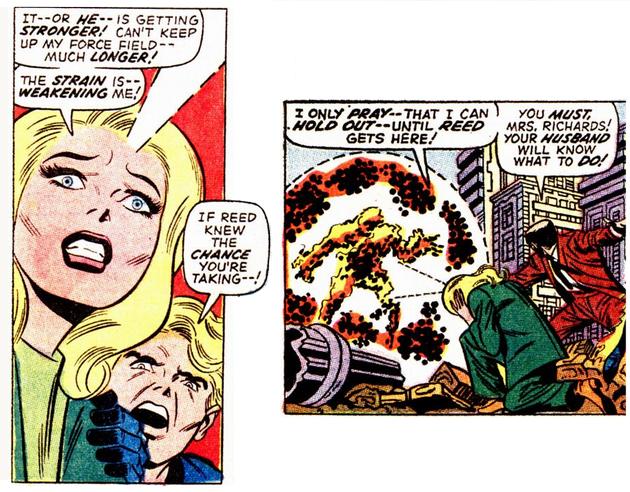
And what of Crystal? The very first page of this issue, the first
story arc begun since Kirby left, shows her beginning to faint. Living
on Earth is too hard for her weak, gentle, delicate body. Stan wastes no
time in getting rid of her. Crystal
committed the unforgivable crime of being equal to the men, and for the
rest of her career at Marvel she will be written as a woman who will
sleep with anybody. That will show her.
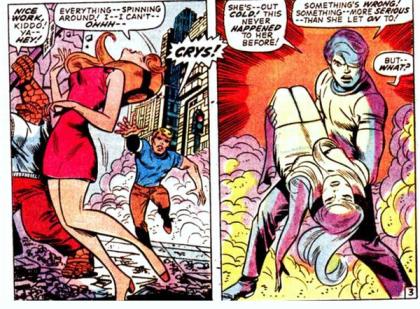
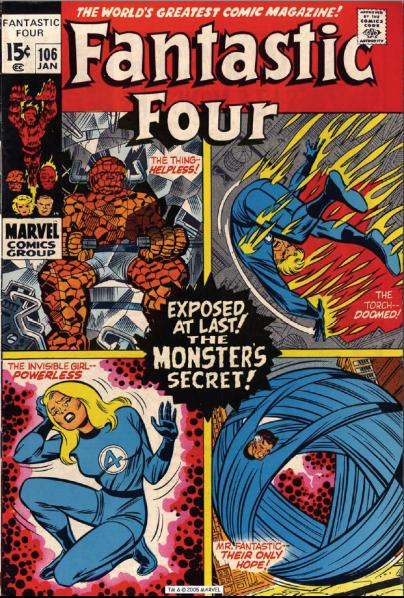
And inside, guess what? That's right, Sue faints again! Without Reed, Sue is helpless.
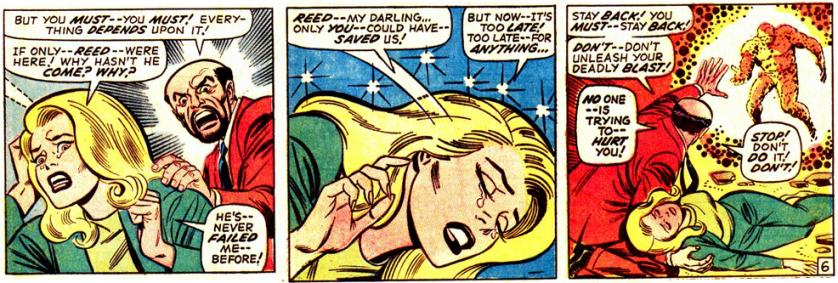
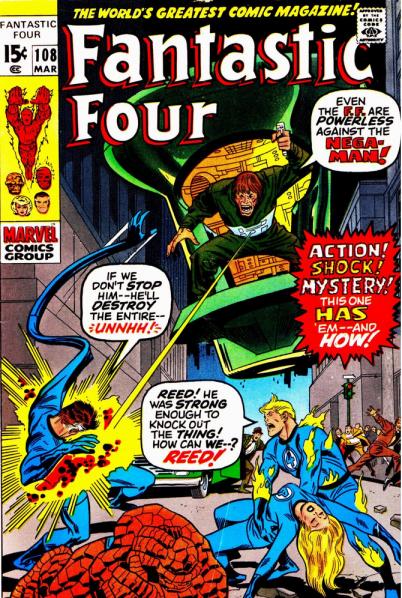
(The inside of FF 108 started as an unused story by Jack Kirby, but
Stan Lee didn't like it. and had it cut up and largely redrawn. But
that's a whole other topic.)
In the next issue Sue is not fainting for a change, just looking
scared, as the men go off to do the dangerous work without a woman to
slow them down.
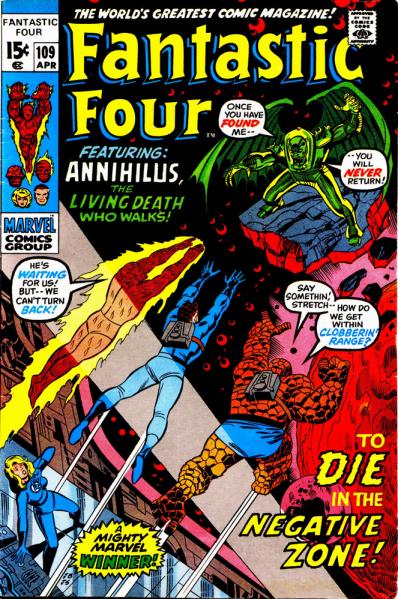
In the next issue Sue needs to cling to her younger brother for
support.
But wait, what's this, a strong woman on the cover? She's a witch. It
seems that women are either helpless without men or they are ugly old
witches.
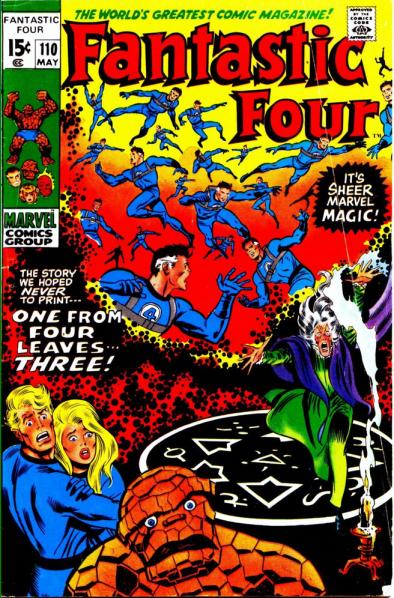
Without her husband Sue cannot cope. She goes to pieces. Her younger brother and the other men have to make things right.
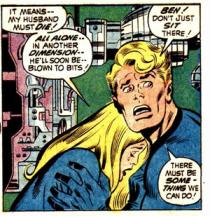
The next two issues don't bother with showing Sue on the cover at all, an she doesn't do much inside either. The next time she is on a cover in a subservient pose, holding Reed's manly chest.
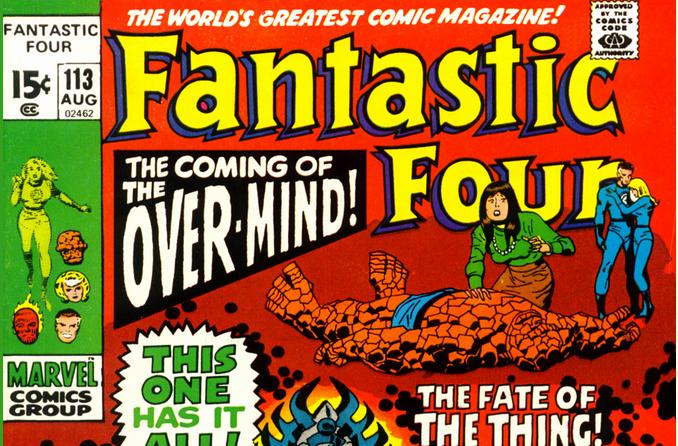
On the next issue's cover she just looks confused and lost while the men do the work.
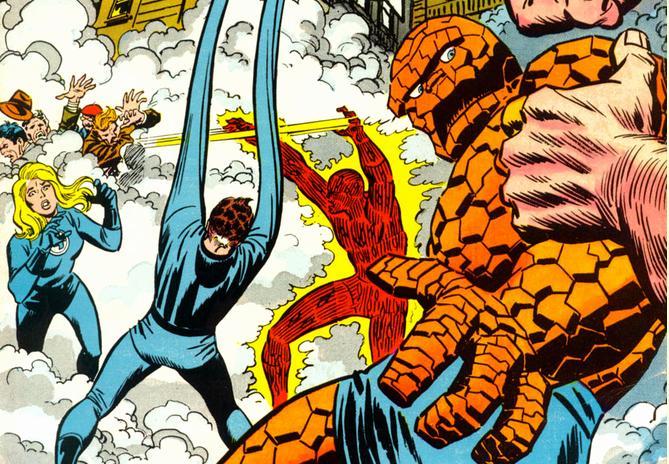
On the next cover, Sue just looks scared while Reed and Johny are the
ones actually doing something. But how can they stop Reed? He's Reed!
The great Reed!
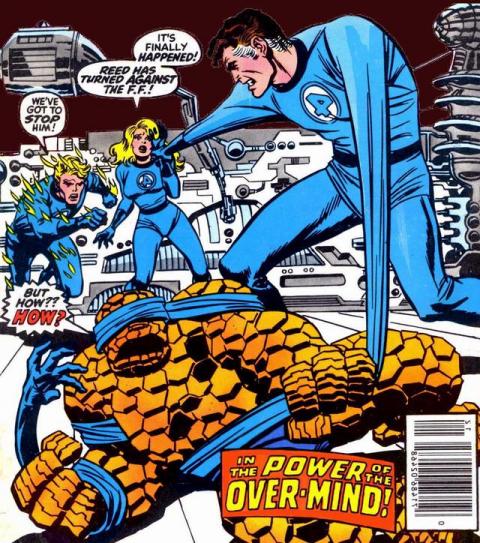
On the next cover Ben is fighting, Johnny is fighting, and Sue just stands there looking scared.
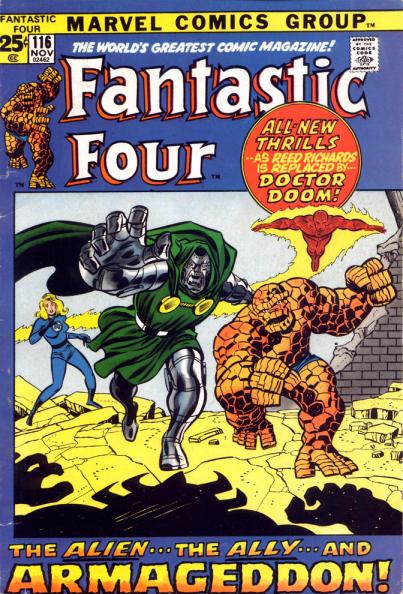
But inside Sue finally does something useful! She saves the team? How can this be?
That's right. You guessed it. Stan Lee didn't write this issue. This is the first issue both plotted and written by Archie Goodwin.
The next issue is also not by Stan. And the the women are just as capable as the men.
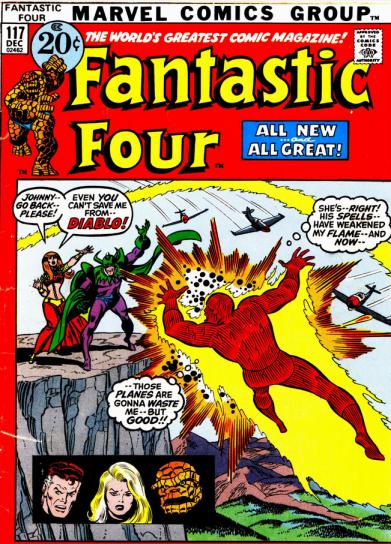 ]
]
This is great! A woman is taking charge, and she's not a witch! True,
Sue is helpless, and Crystal is controlled by a man. This is her first
appearance since she was kicked off the team, and she has to be
controlled by a man.
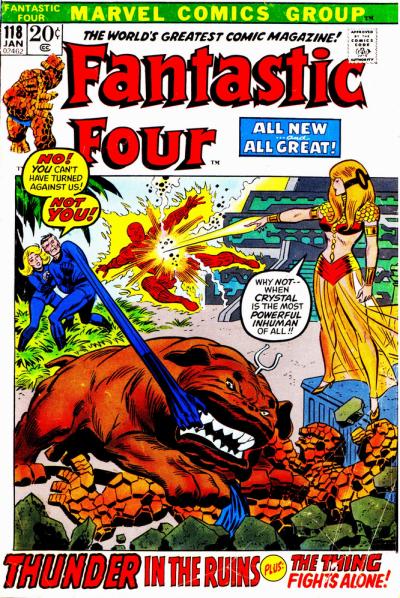
Then at the end a man frees her,and she collapses into his strong manly arms.
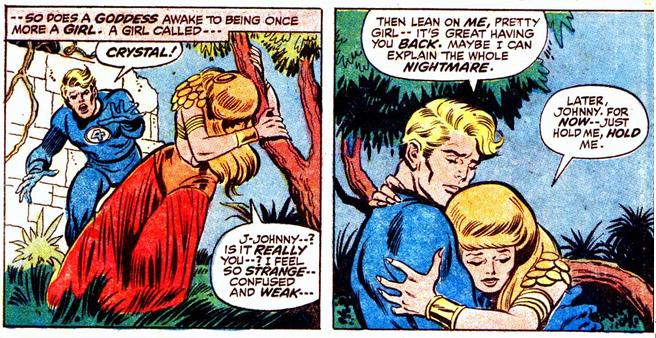
This issue has a back up story, where the only woman is an even more vacuous version of Sue, and only exists to admire the man who shows off the most. It's like watching brainless male birds trying to impress equally brainless females. In the story the one intelligent person is ugly, so of course he cannot get the girl. It wasn't just Stan Lee who had a sexist view of women.

Sue doesn't feature much in the next issue, but she does OK. Then we come to issue 120.
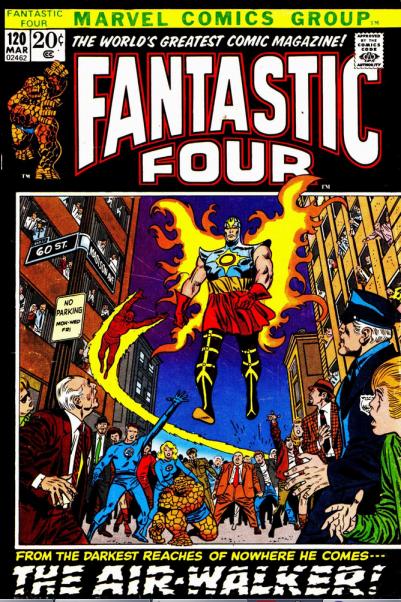
What's this? The men are in charge again, and all Sue can do is stand behind Ben and look worried. And inside, while Sue does some simple stuff it is just not enough.

Sue is becoming useless again. Why is this? Yes, you guessed it, Stan is writing again.
In the next issue she continues being weak.
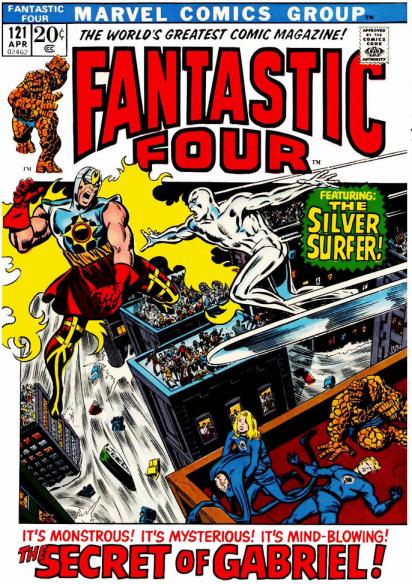
Inside we get a good comparison between Kirby's Sue and Lee's Sue.
Remember how
Kirby once showed the team thrown into the ocean? Remember how Sue
instinctively saved them all? Well Stan's version of the same danger has
a different outcome. Sue just faints and has to be rescued by Reed.
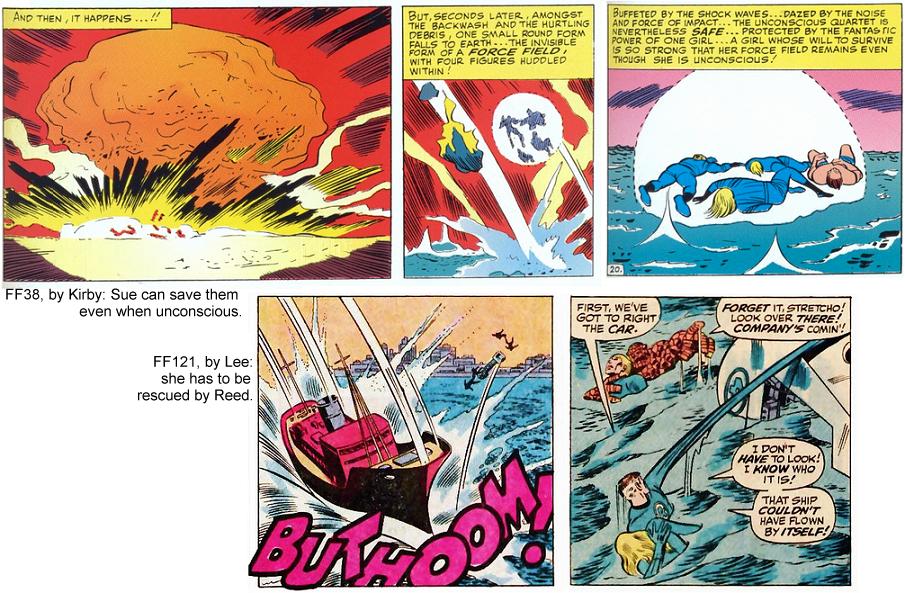
On the next cover Reed has to provide an escape route so that Sue can run away.
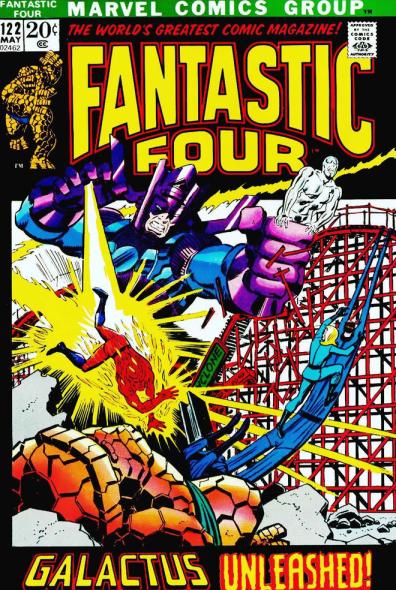
Inside, Sue's force field is so weak that she can't even save two nearby people at once. Luckily a man is around to save her.
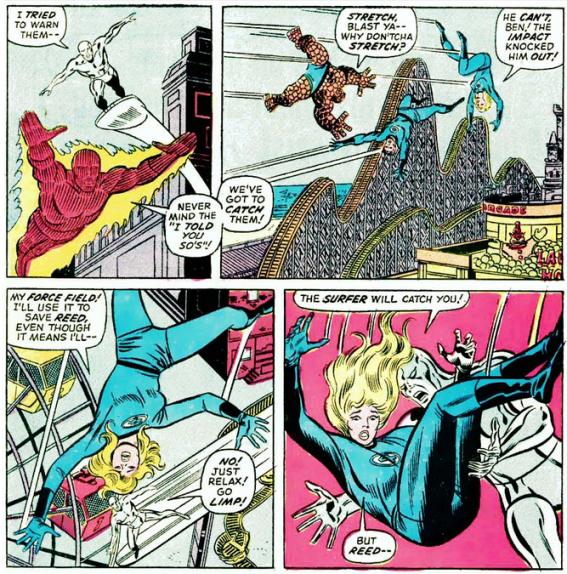
On the next cover she practices a brand new "I am scared" pose. Who says Stan Lee and Jon Buscema can't be creative? And it's such an original story too.
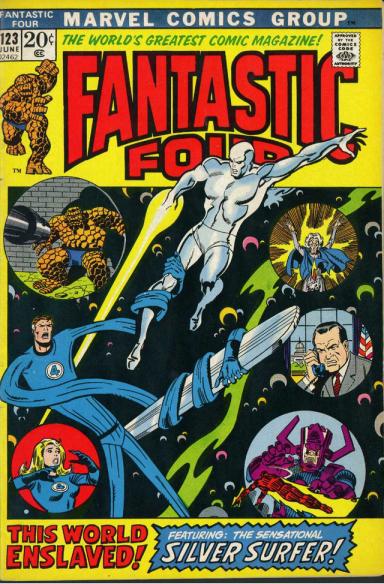
FF 123 is probably Stan Lee's last plotted issue (see the main commentary for why).
And Sue has finally found her natural role. Her only job in this issue
is as a receptionist. She stays home and answers the phone while Reed
Richards is outside saving the world.
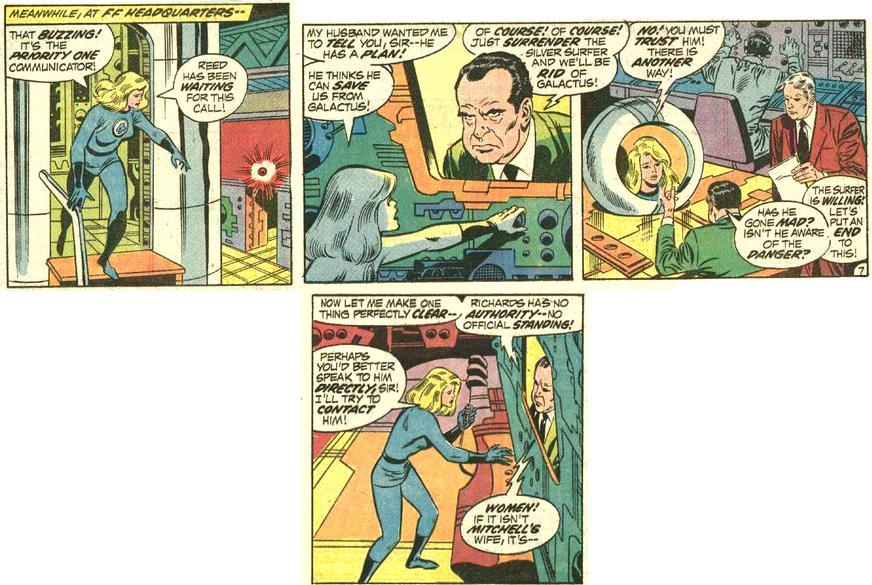
The next issue was probably plotted (uncredited) by new young guy Gerry Conway. But Stan was still in charge, as we can tell by it being a recycled story where Sue has fainted on the cover.
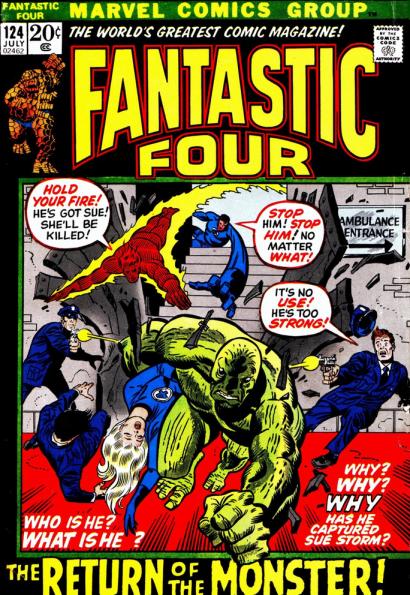
Sue does not appear on the next cover, but features at the start and
end, first being helpless, then finding her force field is too weak, and
finally rescued by a man.
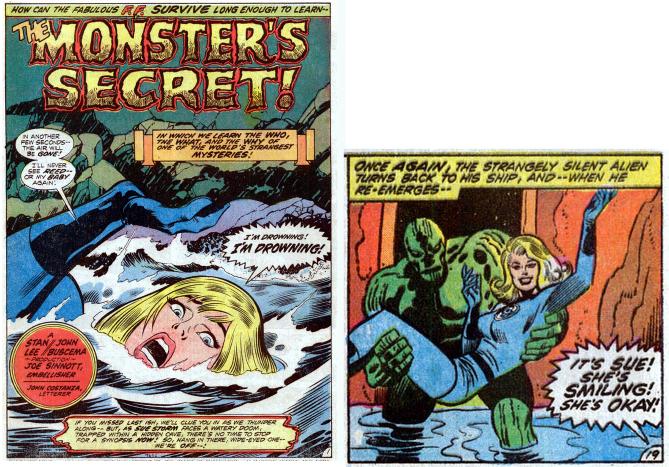
And that was Stan Lee's last issue. The next couple of years are by
Roy Thomas and Gerry Conway, who were both trained by Stan. Sue is
still weaker than the others, but not by so much. Clearly her weakness
feels really wrong to the other writers. As soon as Stan is gone, Roy
Thomas has Sue leave the team and he brings in two very strong female characters.
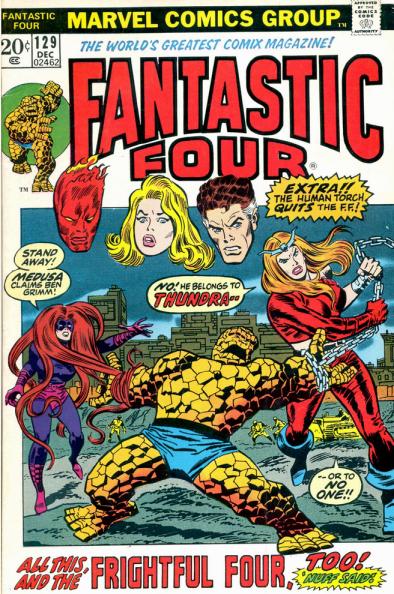
Things gradually get better for Sue, but... heck, I am tired of attacking Stan Lee's writing.
For more about Sue's strength see her own page.
Let's finish by focusing on Stan Lee's writing strengths.
Stan Lee's writing was not worse than Kirby's, but different. Kirby was meat and Lee was milk. But milk is not "less important" than meat. It may have been "necessary" to show women being rescued, to grab the casual readers of the time. it was a different age. So Stan;'s writing on women, though problematic and dated, may have had its merits. Other things that Stan wrote (and Jack did not) are far more impressive.
The noble death
Volume one of the Comics Journal collected library is full of interviews
with Kirby, and essays about his greatness. This is the mother lode for
Kirby fans like me. But it contains a fascinating essay by Earl Wells,
entitled "Once And For All, Who Was The Author of Marvel?"
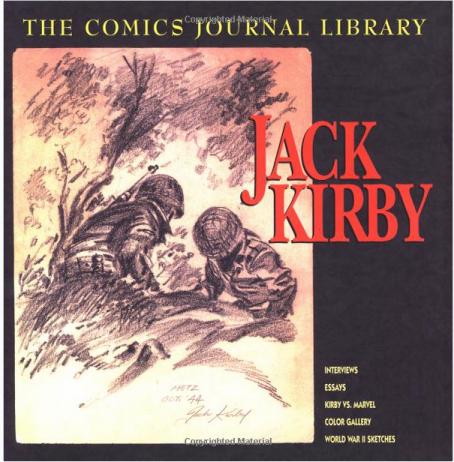
The essay praises Kirby for all the reasons I have, but focuses on one of Stan Lee's contributions: whenever you see a hero die a noble death, you can almost guarantee that part is by Stan Lee. The poignant death of Franklin Storm? That's by Stan Lee. The noble sacrifice at the end of "This Man This Monster"? That's by Stan Lee. These are unforgettable, powerful moments, and we have Stan Lee to thank for them.
Of course, as a Kirby fan I have to note that Kirby has good reasons for not writing noble deaths. Kirby (unlike Stan) actually fought in World War II, and knew that a death is never noble. He was always on the side of the underdog, and he did not want any "red shirts" - characters who's only role was to die to make the leaders look good. It creates a class system, where the "super heroes" are not really heroes at all because they are never in danger of dying (at least not permanently). Others die for them. For someone who sees every point of view the "noble death" is a cheap trick and problematic. Serious writers don't do that sort of thing. Or if they do, it will usually be the star of the book, and permanent - who can forget the end to A Tale of Two Cities?
Kirby had some deep, wonderful thoughts on death, but that is another topic. If you want a story that hits the casual reader in the face and tugs the heart strings, you can't beat the noble death. Like a great popcorn movie, for the short time you're in the zone it rips at the emotions. It instantly reaches the heart and it is unforgettable... as long as we don't think about it too much. "This Man This Monster" would have never had its mass impact without that ending. And the ending is all Stan.
The Marvel Universe
Stan Lee created the Marvel Universe. It was his idea to have the
characters cross over. He did it just to sell books, sure, but it
worked, and it was awesome. This is not a trivial thing! Stan Lee
created the concept of the freaking' Marvel Universe!!!!!! It seems
clear from Kirby's self written work - e.g. his DC work, or his Marvel
work when he came back, that he intended his stories to inhabit their
own universe, and only had cross overs when forced to.
Once again, Kirby's plan was better for a serious writer. For example, when he came back to Marvel and wrote Captain America, he wrote a story featuring the first ever visit from an alien. That would be a great story! The world's first alien visit"! But Marvel had to change that because of course the Marvel Universe has hundreds of alien visits. So in Kirby's story it would have been amazing, and in the Marvel Universe it was routine and uninteresting. In general, the universe makes good stories harder to write, and more superheroes means less danger. For serious writers a joined up universe is really, really hard work to write, and would soon lose the reader. But for escapist literature you can't beat it! And if you pick and choose your personal fan canon (or alternatively choose not to examine it too closely) the entire gigantic edifice works great!
The Marvel Universe is an amazing concept, its scale is unparalleled in all human history. and Stan Lee invented it.
The gate keeper
Stan's writing is what allowed Marvel Comics to thrive. They are what
allowed Kirby to become famous. Sure, in a perfect world great writers
would be rich and we would not need publicity people. But this is
not a perfect world and without publicity great artists are not
recognized. I certainly did not recognize Kirby at first. I had to spend
years reading his stuff to appreciate it. And now that Stan (and others
like him) is doing such a great job of creating blockbuster movies
based on Kirby';s creations, the world will keep discovering the King
for years to come. Yes, in a perfect world there would be not writers
who do little more than dumb down others' work, but in the real world
right now we do need them, and thank heavens for Stan Lee!
Stan's writing created the joined up Marvel Universe and allowed it to grow. Left to Jack Kirby, this universe would not exist. it would not have unforgettable noble deaths, it would not be accessible to the casual reader. Stan Lee gave us the most amazing mass market escapism, and enabled people like me to find the "harder" writers like Kirby. For me, now, Kirby is the greatest comic writer of them all. But neither is "better" than the other. We need them both equally, and when they came together they made the greatest comics in the world.
